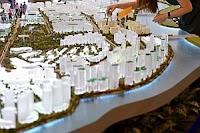Singapore's current population of about 5.3 million live on 71,400 ha of land. By 2030, some 76,600 ha could be available.
Analysts have already started debating the impact that this Land Use Plan would have on the property market. The government highlighted that the pace at which land will be rolled out may depend on market conditions.
National Development Minister Khaw Boon Wan said: "As planners, our mantra is . . . 'Prepare for the worst but hope for the best'. . . .The figure 6.9 looks aggressive. But from planners' point of view, we need aggressive figures and projections so that we can prepare for the worst. The worst is if we plan for the best then if the worst comes, then we will be under-providing, as what has happened in the last few years."
The proportion of Singapore's projected land area in 2030 that will be used for housing will be 17 per cent, up from around 14 per cent currently. Industry and commerce's share of Singapore's land supply too will rise from roughly 13 per cent to 17 per cent to power Singapore' economic growth.
The Marina Bay area can support the expansion of the Central Business District by at least another one million square metres gross floor area of prime office space. Currently, the Central Area which includes the CBD (which in turn includes Marina Bay) has six million sq m of prime office space. There will be capacity to increase the figure to more than 11 milion sq m by 2030 in the Central Area - if there is demand. Singapore will develop a "North Coast Innovation Corridor" spanning Woodlands Regional Centre, Sembawang, the future Seletar Regional Centre, and the learning corridor and creative cluster in Punggol.
To support the growth of the manufacturing sector, sufficient land will be set aside in Woodlands, Sengkang West, Seletar, Lorong Halus, Pasir Ris and Tuas. By 2030, Singapore will also develop more commercial centres outside the city, amounting to 13 million sq m to provide more employment and amenities close to where people live.
As part of the plans to boost the island's stock of homes by 700,000 units to 1.9 million by 2030 to support a rising population, the Republic is planning for new housing estates in the Central Region - at the former Bukit Turf Club, Kallang Riverside, the waterfront area around Keppel, and Bukit Brown.
In the longer term, a "Southern Waterfront City" with commercial and housing projects will be developed after the existing container port facilities in the City Terminals and Pasir Panjang Terminal are consolidated and relocated to 1,700 ha of reclaimed land in Tuas Port. This will be one of three major land reclamation sites, along with Pulau Tekong (2,000 ha) and Jurong Island (600 ha). Existing military training areas across the island will be moved to the expanded Pulau Tekong, freeing up land for other uses such as housing.
Increased connectivity is generally seen as a plus factor for property values.
Source: Business Times –1 February 2013

No comments:
Post a Comment
No Spam, No Abusive Languages. Thank you for your cooperation!